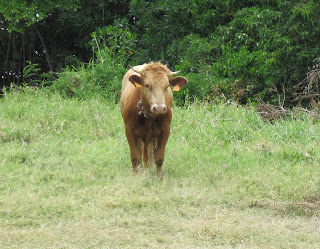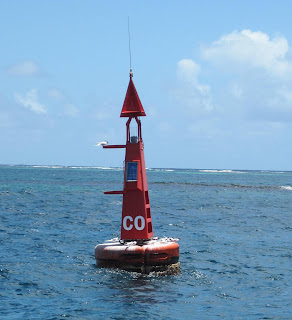Apparently even beachgoers might need to make an emergency
phone call, hence the public pay phone right on the beach near Gros Anse de
Salines.
Tuesday, May 29, 2012
Saturday, May 26, 2012
Star Watching
| Comet starfish |
Here’s a new (for us) kind of starfish we found off the beach just
north of St. Anne in Martinique. It’s a comet starfish. It’s called comet
because when, reduced to only a single leg, it can regenerate the rest of its,
and while doing so, it looks like a comet (bunch of small legs, and one long
one). Click here
to see some examples of the regenerating starfish looking like a comet.
| Chris returning the starfish to deeper water |
Wednesday, May 23, 2012
Natural Resource: Solar Power in Martinique
I know, I know, you’re probably getting tired of me posting
blogs noting how ecologically friendly habits seemed to be encouraged more on
the French islands than any of the others we’ve seen. But here’s another. These
pics are neighboring houses near Baie du François with nice arrays of solar
panels. It’s gotten so whenever I see an empty expanse of roof, particularly in
sunny regions, it just looks wrong. Don’t even get me going about Florida, with
huge tracts of housing under the glaring sun and nary a single solar panel. Our
solar panels came with a 20-year warranty, no moving parts, and no maintenance,
and have performed admirably.
Sunday, May 20, 2012
Participating in the Local Races
Okay, so we didn’t actually participate, but we were
involved in our own small way. Our role, or more precisely, Mr Mac’s role, was as a turning point
for the local racing boats. I swear they were vying to see who could get
closest without actually hitting us. It was a little nerve-wracking when we’d
see them coming back around, but it did give us nice close-up views of the
interesting boats and the gorgeous
sails, and the guys were nice, calling out to us as they went by.
Location:
Presqu Ile, Le François, Martinique
Thursday, May 17, 2012
Baie du François, Martinique
 |
| I loved the colorful boats of the local fishermen! |
| Fish house and fishing boats on the muddy river |
| Old building... |
| ...new building |
Our next stop was Baie du François. The channel (with real channel markers)
weaves between the reefs before opening up into the bay where we anchored. The Rivière du François flows into the bay
here, so the water was pretty opaque due to the considerable rainfall we’d
received the previous day; the river itself was like chocolate milk. We
dinghyed ashore and walked to the village of François. Outside the village
center was a little neighborhood with an ugly apartment building and cute houses, each property delineated by
fences, most not so cute. The architecture in the French islands
really is distinct from the non-French islands—low houses with broad roofs
instead of the stilted houses more commonly seen elsewhere. The village itself
was small, with a newly constructed church across from the police station in an
historic building, and an interesting cemetery spread out over an entire block.
We stopped at a market to pick up a couple of essentials that we were running
low on: a baguette and local rum. We also picked up a little friend on the walk
back, a dog who only loved me for the bread I carried.
| Essential shopping in the French islands |
 |
| A new friend |
Location:
Fregate Est, Le François, Martinique
Monday, May 14, 2012
Baie du Simon, Martinique
| Local dock |
| Flamboyant tree starting to bloom |
| Fresh French pastries and baguette |
 |
| Friendly neighborhood bull |
 |
| Mr Mac anchored off of Îlet Long |
Our first stop on the windward side of Matinique was Baie du
Simon. We anchored just off the shore of Îlet Long, a small island dotted with
a few houses. The next closest boat was anchored about a mile away, and we’re
not sure there was even anyone on it. That’s not to say that there were no
boats. Fishing boats visited the reefs every day, and tended their buoyed pots,
and some power boats jetted around on the weekend. We dinghyed in to the local
dock to go for a walk. It was an agricultural/residential area, with fields of sugar
cane and bananas, the Habitation Clément rum distillery, and an old plantation
house on the hill, as well as some small neighborhoods. The best part was the
little boulangerie (bakery) just up the hill. We could see people inside laying
out the baguette dough, and they had a little counter outside, so we purchased
a baguette and a couple of French pastries (when in Rome…). The pain chocolate
(croissant dough with pieces of good-quality chocolate wrapped inside) we got
here was probably the best I’ve had. We ate the pastries while sitting on the
dock, and saved the bread until we got back to the boat. We did some snorkeling
here. The shallow reefs were pretty bare, but once you got deeper, they were
nice, with lots of interesting life. One reef was curious-looking from a
distance, and once we got closer, we saw that it was dead coral covered as far
as you could see by hundreds or thousands of sun anemones, which are
golden-colored and broad with short tentacles that feel really Velcro-y when you touch them. You could barely tell where
one anemone ended and the next one started unless you touched one and it
retracted its tentacles. There were lots
of fish traps around, which accounts for the lack of large fish on the reefs.
Location:
80 Pointe Cerisier, Martinique
Friday, May 11, 2012
Back on the Windward Again
 |
| Look at all the protective inner and outer reefs you can tuck behind on the windward side of Martinique |
| Breakers on the reef are good indicators of the channel edge |
We had heard from several people about how nice the windward
side (east coast) of Martinique was, and if you’ve read our previous blogs, you
know that we like windward sides for their reefs and isolation—no masses of
charter boats like you find in and around the major leeward anchorages. So around we went. Spring seems to be a good time to go; the
velocity of the tradewinds has decreased from its winter highs, so you don’t
have to fight through opposing winds and high seas. In fact, we had quite a
pleasant sail over, only motoring once we got behind the reefs, since we didn’t
know the area and wanted the extra maneuverability. Our Doyle cruising guide doesn’t
cover this area, instead recommending a Martinique-specific guide, available in
either French or English. We checked several chandleries for the book, finally
finding it at the Clipper Ship in Marin. Unfortunately, they only had the
French version, which we were ready to go with except that the price was 57
euros, more than $70 US. That’s pretty steep for a skinny book that we couldn’t
read without an English-French dictionary. We ended up using just the charts we
had, which we discovered were pretty accurate. The reefs are distinct, with
deep channels between them, and with careful visual piloting, we had no
problem. A couple of strategic areas, like the southern entrance behind the
reefs, actually had honest-to-goodness aids to navigation, which are few and
far between in the islands. The interesting thing about this area was that, although
it looks completely open between you and the open ocean, the overlapping ranks
of reefs break the seas so well that the anchorages are quite calm. You
do get a bit of wind-driven chop if the winds are up, but the fetch is minimal,
so it doesn’t amount to much. All in all, quite lovely. I’ll give more details
about our time here in future blogs.
 |
| Real channel markers! A rarity down here. |
Location:
80 Pointe Cerisier, Martinique
Subscribe to:
Posts (Atom)
